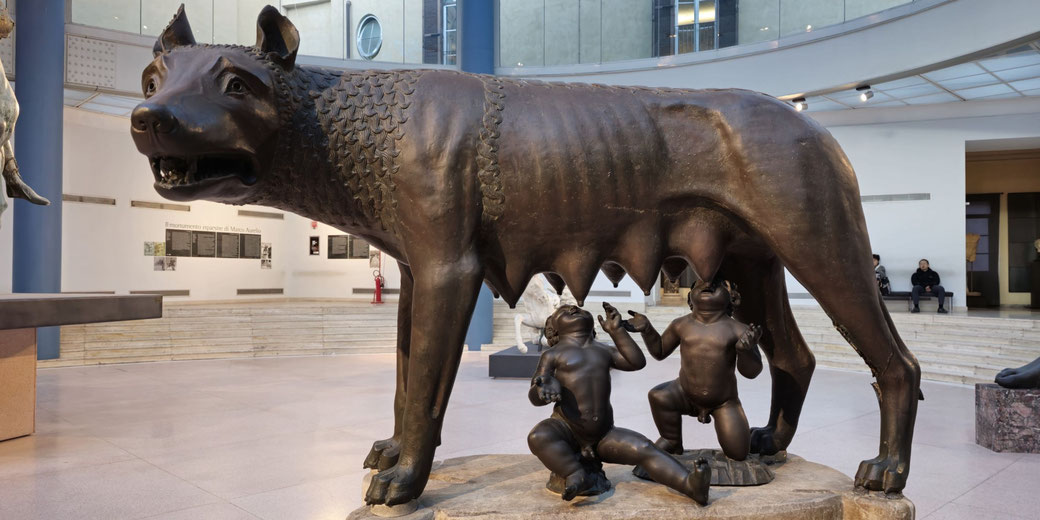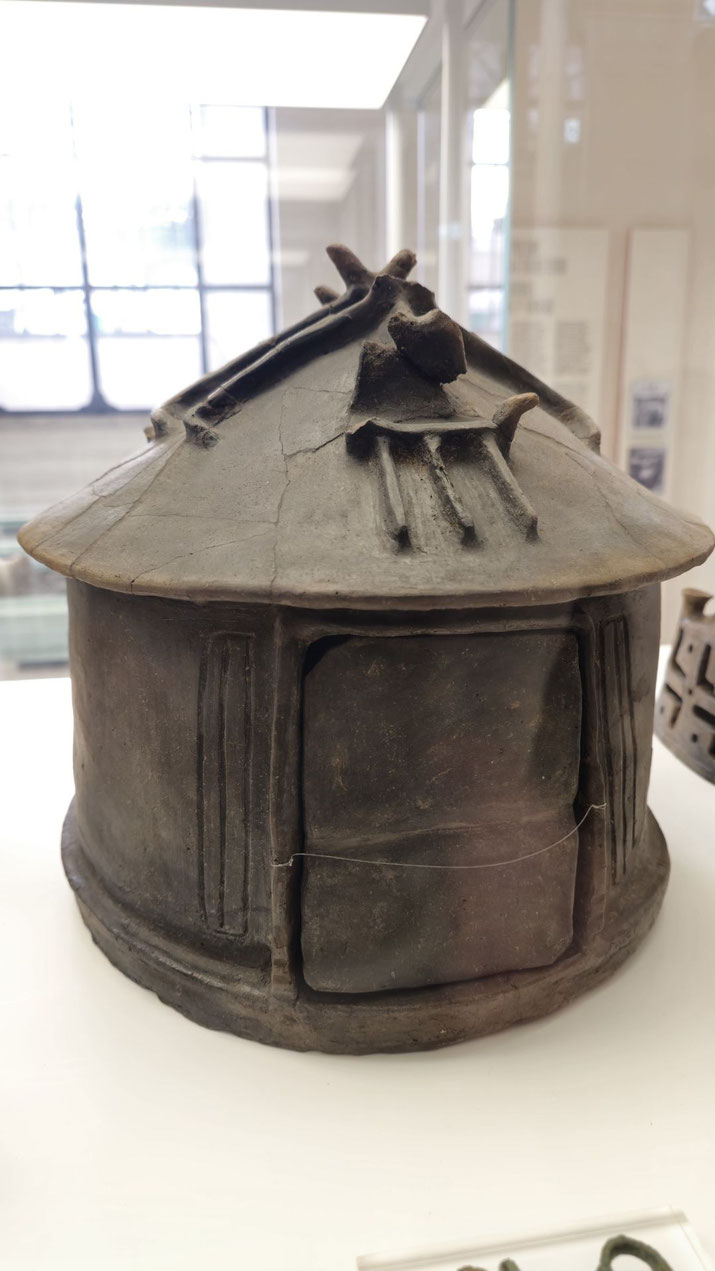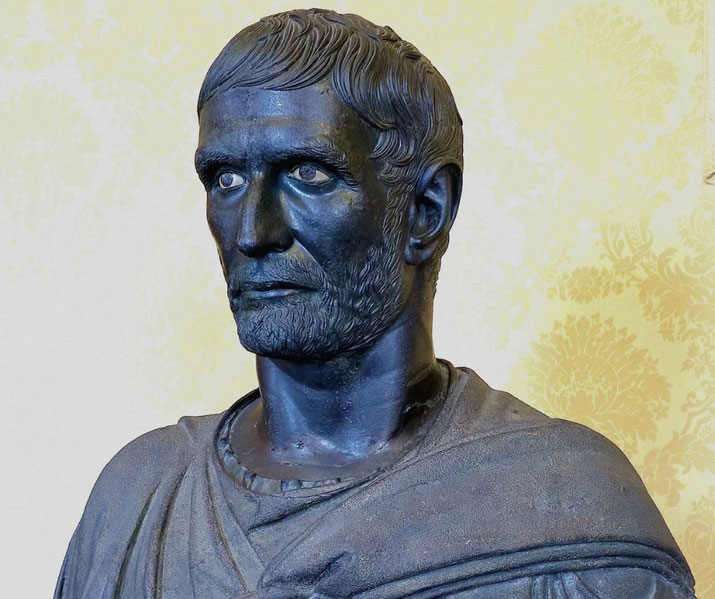Aeneas, Romulus, and the founding of Rome

Many people are familiar with the story of ancient Rome. The city was founded by Romulus and Remus, twin brothers who were abandoned in the wilderness as infants and raised by a she-wolf.
However, this is only one of the many myths and legends associated with the foundation of the city.
At different times in the history of ancient Rome, the Romans themselves told different stories about where their city and empire came from.
The various accounts do not really work well together, which makes most modern historians reluctant to trust their reliability as genuine sources of information about where the city of Rome originated from.
Aeneas
One of the origin stories of Rome comes from a poem called the Aeneid, written by the ancient Roman poet, Virgil.
It was written during the early Roman Empire and was inspired by an earlier ancient Greek poem, the Iliad, which was written around 800 years prior by a Greek poet called Homer.
The Iliad told the story of the Trojan War, in which the city of Troy was sacked by a coalition of Greek armies.
The Aeneid continues this story and describes what some of the Trojans did after their city was destroyed.
According to this account, a Trojan prince named Aeneas escaped from Troy with a group of survivors.
They eventually made their way to Italy, where they settled down and founded a city called Lavinium, which was south of where Rome would eventually be founded.
Aeneas is depicted as a heroic figure who represents the values of Roman civilization.
It is important to understand that the Aeneid was a work of mythology and fiction, which was written at a time when Rome was expanding its empire and trying to legitimize its power.
By claiming descent from the Trojans, the Romans were able to associate themselves with the great Homeric tradition and make their own empire seem like a natural continuation of time of the heroes of old.
The problem with this origin story is that there is no archaeological evidence to support it.
In fact, most historians believe that the Trojan War was a myth, and that the city of Troy was not actually destroyed.
As a result, historians do not use the information presented in the Aeneid as a source of historical information about the early history of ancient Rome.
Romulus and Remus
The more famous version of the creation of Rome involves two semi-divine children: Romulus and Remus.
This story begins with the twins' mother, who was a vestal virgin named Rhea Silvia, who came from a city in Italy called Alba Longa, located just south of Rome. Vestal Virgins were Roman priestesses who served the goddess Vesta.
In this story, Rhea Silvia was raped by Mars, the god of war, and became pregnant with Romulus and Remus.
Since vestal virgins were required to remain virgins, Rhea Silvia was considered to have been at fault and, as punishment for her transgression, she was imprisoned.
When the twins were born, Rhea Silvia's father sent some of his servants to drown them in the Tiber River.
They couldn't follow through with the murder and, instead, left them on the riverbank, where they were discovered and cared for by a she-wolf.
Eventually, the two boys were found by a shepherd and were then raised by him and his wife as if they were their own children.
As the boys grew up, they became leaders of rival gangs in the area of what would become the city of Rome.
Eventually, they had a disagreement about where to build a new city and Romulus killed Remus in a fit of rage.
He then went on to build Rome, which he named after himself, on 21 April 753 BC, and became its first king.
The main problem with this origin story is that it was written long after the events it claims to describe.
Also, there survives more than one version of the story from different Roman writers, many of which contradict others.
The earliest recorded version of it comes from the ancient Roman historian Livy in his History of Rome, which was written over 700 years after the city was reportedly founded.
This means that it is impossible to know how much of the story is true and how much was made up by later Roman historians.
Combining Aeneas and Romulus
The story of Romulus and Remus has some similarities with the Aeneid, in that it features semi-divine characters who represent the values of Rome.
However, there are also some significant differences.
First of all, Virgil's Aeneas is a heroic figure whereas Romulus is more of a ruthless dictator.
Secondly, the Aeneid tells the story of Lavinium's foundation after the Trojan War while the story of Romulus and Remus takes place centuries after that war.
Regardless, some historians, both ancient and modern, have sought to link both mythologies together in an attempt to provide a cohesive narrative.
In these versions, they begin with the story of Aeneas' flight from Troy and his arrival in Italy.
Once in the region, Aeneas founds Lavinium, which has a booming population.
To ease the increasing size of Lavinium, they built the city of Alba Longa, which is where Rhea Silvia originates.
Therefore, it was the descendants of Aeneas through the city of Alba Longa that provide the link to Rhea Silvia and her father.
This allows the Romulus and Remus myth to continue the story.
Archaeological evidence
So, if we can't trust the myths and legends, what do we know about the origins of Rome? The answer comes from archaeology.
Archaeological evidence shows that Rome was not founded by a single person or event, but rather developed slowly over time.
The site of Rome grew from a series of small settlements to a large city over the course of several centuries.
Excavations in the area have uncovered a number of different burial remains, the earliest of which date back to around 1000 BC.
Therefore, people must have been passing through the region for some time before that.
The first settlers were likely small groups of farmers who arrived in the area during the late Bronze Age or early Iron Age.

The presence of burials indicate that some villages must have existed at this time, but they were small and unorganized.
Eventually, these early Roman villages coalesced into a single city on the banks of the River Tiber and, sometime around 750 BC, the first huts can be found on the Palatine Hill.
However, by 600 BC, there was a significant community of around 10,000 people on the site with well-built houses, temples, and public parks.
It is clear that this city went through a period of rapid growth during this time.
The seven hills of Rome
Another piece of evidence that Rome developed slowly over time is the fact that it is built on seven hills.
This is not something that would have been planned by a single individual. Rather, it reflects the organic growth of the city.
Each hill was likely settled by a different group of people at a different time. As the city grew, these different groups came into contact with each other and eventually merged into a single community.
The seven hills of Rome are: the Aventine Hill, the Caelian Hill, the Capitoline Hill, the Esquiline Hill, the Palatine Hill, the Quirinal Hill, and the Viminal Hill.
The Roman Forum
The Roman Forum is another piece of evidence that Rome developed slowly over time.
In later Roman history, the Forum was the central meeting place of the city, where most of the important political and religious buildings were located.
The Roman Forum was the center of public life in Rome. It was used for a variety of purposes, including markets, political debates, criminal trials, and religious ceremonies.
However, this area was originally a flat marshland located between the seven hills of Rome.
At some point in Rome's early history, the local inhabitants were able to drain the marsh and create a flat, open area where they could meet and conduct business.
The first buildings in the Roman Forum were likely built in the late Bronze Age or early Iron Age.
However, the forum underwent significant changes during the Republic and Empire periods.
During these periods, new temples and public buildings were constructed. The forum also became increasingly crowded as the city grew.

The seven kings of Rome
Regardless of how Rome began, the Romans claimed that in the early days, the city was ruled by a series of seven kings.
Each king became an important figure in establishing the infrastructure and traditions of Rome.
Most modern historians believe that the seven kings were mostly mythical and may never have existed in reality.
The fact that there were only seven kings in a 250-year period (which would mean each ruled for around 35 years each), seems very implausible.
However, since all historical records of Rome's early history were destroyed in the early 4th century BC, these mythical accounts are all we have to understand how Rome began.
The first king was Romulus. He was responsible for founding the city and building the first walls around it.
A number of very important traditions in Roman political life are attributed to Romulus, including the creation of the Senate, and the first 'triumph' (the celebration through Rome a military general achieved for an outstanding victory leading Rome's armies).
The Romans claimed that Romulus ruled the city for 30 years before disappearing in a storm one night and becoming a god.
The second king was Numa Pompilius. Most Roman religious practices and traditions are usually attributed to this king, as he was considered to be focused on earning the blessing of the gods for the new city.
As a result, he is credited with establishing the ten-month Roman calendar and founding many important priesthoods, including setting up the Vestal Virgins in the city.
The third king was Tullus Hostilius. He is known for conquering the nearby city of Alba Longa and expanding Rome's territory.
The fourth king was Ancus Marcius. He is credited with building the first bridge over the River Tiber and founding the port of Ostia.
The fifth king was Lucius Tarquinius Priscus. He is known for a number of achievements, including expanding Rome's territory further, draining the marshlands around the Forum by building the Cloaca Maxima, constructing the Temple of Jupiter on the Capitoline Hill, and establishing the Circus Games.
The sixth king was Servius Tullius. He is credited with a number of political reforms that established Rome's first census, the construction of a wall around the city, and the creation of a new class of citizens.
The seventh and final king was Lucius Tarquinius Superbus, who was known as a cruel tyrant since he murdered Servius Tullius to take the throne.
Later Roman historians describe him as a paranoid dictator who willingly murdered rivals to his power.
He also ordered massive building projects and forced the Roman people to work like slaves on them.
However, when Superbus' son violently forced himself on a young lady named Lucretia, the Romans rose up against their king.
A force of angry citizens, led by a man called Lucius Junius Brutus, finally expelled Superbus from the city in 509 BC and monarchy was outlawed.

The Roman Republic
After the expulsion of the seventh king, Rome became a republic. This means that it was governed by elected officials, not by kings.
The Romans were incredibly proud of their republic and it became a central part of their identity.
In the Roman republican system, rather than a single king holding all of the power, authority was divided among a number of different institutions.
The two most important of these were the Senate and the Assembly.
The Senate was a group of wealthy landowners who had inherited their positions from their ancestors.
It was said that Romulus himself had gathered 100 leading men of Rome to be his council of elders, which became the first ‘senate’.
During the time of the monarchy, they had advised the king on matters of state and passed laws on his behalf.
The Assembly was a group of citizens who elected officials and passed laws. The most important officials were the consuls.
They acted as the chief executives of the state and held office for one year.
The Patricians and the Plebs
During the Roman Republic, Roman society was divided into two classes: the patricians and the plebeians (often just called 'plebs').
The patricians claimed that they could trace the heritage of their families back to the time of the kings.
This privileged position allowed them to dominate Roman politics. The patricians held all of the power in Rome.
They controlled the Senate, and most of the important offices.
The plebs, on the other hand, were excluded from holding political positions in the early republic.
However, they weren't excluded from politics all together. They had the power to vote for, and ultimately decide, which members of the patricians would hold political offices each year.
Generally speaking, the plebeians were much poorer than the patricians, even though they made up more than 90% of the population.
This meant that they were often forced to work long hours for little pay. They were also burdened by high taxes and had less legal rights.
Further reading
What do you need help with?
Download ready-to-use digital learning resources
Copyright © History Skills 2014-2025.
Contact via email
With the exception of links to external sites, some historical sources and extracts from specific publications, all content on this website is copyrighted by History Skills. This content may not be copied, republished or redistributed without written permission from the website creator. Please use the Contact page to obtain relevant permission.





